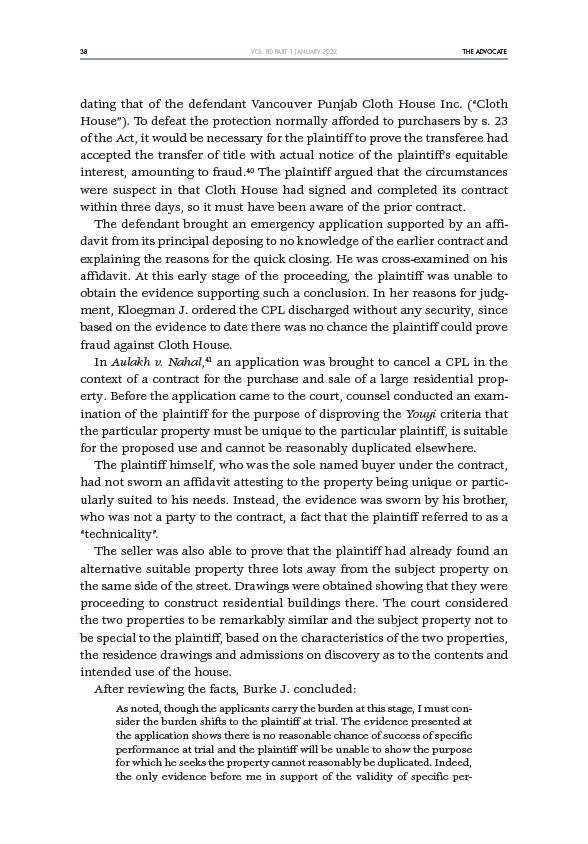
38 THE ADVOCATE
VOL. 80 PART 1 JANUARY 2022
dating that of the defendant Vancouver Punjab Cloth House Inc. (“Cloth
House”). To defeat the protection normally afforded to purchasers by s. 23
of the Act, it would be necessary for the plaintiff to prove the transferee had
accepted the transfer of title with actual notice of the plaintiff’s equitable
interest, amounting to fraud.40 The plaintiff argued that the circumstances
were suspect in that Cloth House had signed and completed its contract
within three days, so it must have been aware of the prior contract.
The defendant brought an emergency application supported by an affidavit
from its principal deposing to no knowledge of the earlier contract and
explaining the reasons for the quick closing. He was cross-examined on his
affidavit. At this early stage of the proceeding, the plaintiff was unable to
obtain the evidence supporting such a conclusion. In her reasons for judgment,
Kloegman J. ordered the CPL discharged without any security, since
based on the evidence to date there was no chance the plaintiff could prove
fraud against Cloth House.
In Aulakh v. Nahal,41 an application was brought to cancel a CPL in the
context of a contract for the purchase and sale of a large residential property.
Before the application came to the court, counsel conducted an examination
of the plaintiff for the purpose of disproving the Youyi criteria that
the particular property must be unique to the particular plaintiff, is suitable
for the proposed use and cannot be reasonably duplicated elsewhere.
The plaintiff himself, who was the sole named buyer under the contract,
had not sworn an affidavit attesting to the property being unique or particularly
suited to his needs. Instead, the evidence was sworn by his brother,
who was not a party to the contract, a fact that the plaintiff referred to as a
“technicality”.
The seller was also able to prove that the plaintiff had already found an
alternative suitable property three lots away from the subject property on
the same side of the street. Drawings were obtained showing that they were
proceeding to construct residential buildings there. The court considered
the two properties to be remarkably similar and the subject property not to
be special to the plaintiff, based on the characteristics of the two properties,
the residence drawings and admissions on discovery as to the contents and
intended use of the house.
After reviewing the facts, Burke J. concluded:
As noted, though the applicants carry the burden at this stage, I must consider
the burden shifts to the plaintiff at trial. The evidence presented at
the application shows there is no reasonable chance of success of specific
performance at trial and the plaintiff will be unable to show the purpose
for which he seeks the property cannot reasonably be duplicated. Indeed,
the only evidence before me in support of the validity of specific per-